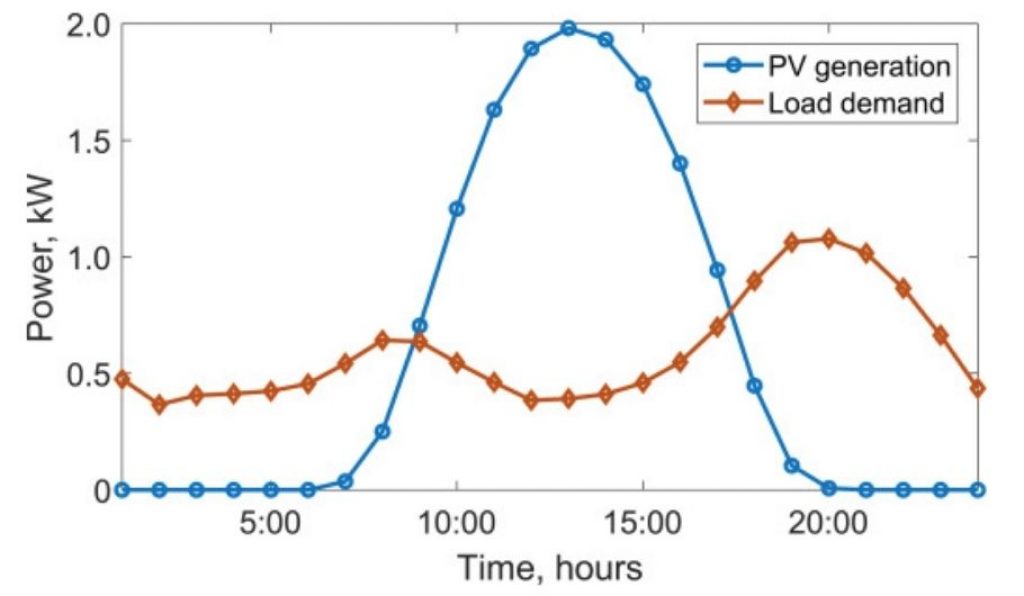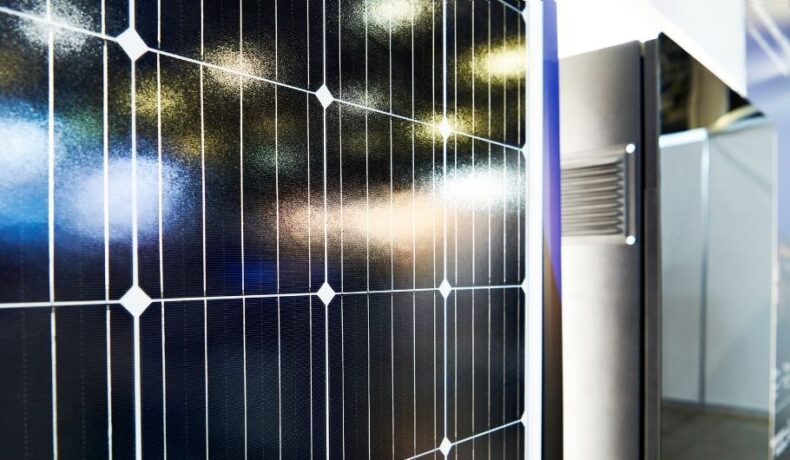You can only produce solar energy during sunlight hours – this is where knowing how to store solar energy at home comes in handy.
Energy storage makes the most sense when there is a mismatch between demand and supply.
In most homes, the daytime energy demand is lower than the nighttime energy demand. In such cases, energy storage makes the most sense.
Energy storage can be further classified into electrical energy storage and thermal energy storage.
In the case of electrical energy storage, you can store the solar energy that your panels produce during the daytime in electrochemical batteries, better known as solar batteries.
Thermal energy storage works according to a similar principle.
In both cases, you will use energy storage to offset demand and supply.
Table of Contents
How To Store Solar Energy At Home?
The below graph represents a typical load profile of a residential house in South Australia. As you can see from the graph, there is a significant mismatch between solar energy production and the energy demand of the household.
In such cases, energy storage makes the most sense and does the following – during the sunshine hours, any excess solar electricity produced gets stored for later use.

Solar energy can either be stored as electrical energy or thermal energy at home. The most commonly used electrical energy storage device is both lead-acid and lithium-ion batteries.
A battery is a device that allows rapid conversion between chemical energy and electrical energy by means of an electrochemical oxidation-reduction reaction between the active materials that are packed in its cell chamber, separated by an ion-conducting electrolyte.
Battery classification depends on whether the stored energy can be recharged or not.
Some of the common battery technologies available in the market are lead-acid batteries, lithium-ion batteries, and flow batteries.
The common battery parameters considered for solar energy storage at home are the following:
- Depth of discharge
- C-rate
- Cycle life
- Charging/discharging efficiency
- Capital expenditure
- Operational costs
To store solar energy in the form of heat, excess solar energy produced during the daytime is absorbed by water or molten salt.
The heated medium is stored in insulated tanks and when there is a demand for thermal energy, heat is extracted from the medium using a heat exchanger.
What Is The Best Way To Store Solar Energy?
Electrochemical energy storage, also called batteries, is the most commonly used energy storage device at homes.
On that note, the two most commonly used battery technologies are lead-acid and lithium-ion. Each of them has its own pros and cons.
Lead-acid batteries are the most widely used battery technology.
They are relatively low cost, reliable, and have a solid lifespan. The technology is uncomplicated and mature. Some of the drawbacks of this battery technology include slow charging, limitation on depth of discharge, and a limited number of charge-discharge cycles.
Lithium-ion (Li-ion) batteries, on the other hand, are one of the most widely utilized energy storage technologies for portable electronics today.
The key characteristics of the battery include high energy density and long cycle life.
6 Tips On Storing Solar Energy At Home
Tip 1: Understand your energy demand
The first step in the process is to understand your daily energy demand. You can do this by estimating the number of appliances used for every hour of the day. You need to look at the power ratings on the appliances and estimate the energy demand for every hour of the day.
Here are the power ratings of some common electrical appliances:
| S.No | Appliance | Power rating (W) |
| 1 | Laptop | 65 |
| 2 | Tube light | 30 |
| 3 | Fan | 45 |
| 4 | Fridge | 150 |
| 5 | TV | 100 |
Tip 2: Determine the size of the solar system
Once you determine the daily energy demand, the next step is to determine the size of the solar system.
For this, you divide the daily energy demand by the average daily solar production (kWh/kWp/day).
For example, a 1 kW solar system in Sydney will produce approx. 4 kWh of solar energy per day.
If your daily energy demand is 20 kWh, then you will need a 5 kW solar system.
Tip 3: Determine the battery capacity
The most efficient way to size the battery system is to size it based on the daily energy demand. For example, if the daily energy demand is 20 kWh, it is advisable to install a 20 kWh battery system.
Alternatively, estimate the excess solar production that you will generate during the daytime and size the battery bank for this excess solar production.
It will be difficult to get this number right and the worst-case scenario is an undersized battery system.
Remember: yes, a battery system is pricey, but having a slightly larger battery bank will save you money in the long run.
The charge-discharge cycles and depth of discharge determine the life of the battery. If you have a larger battery bank, the daily depth of discharge will be shorter and, in principle, will increase the battery life.
Tip 4: Choose a battery technology
Choosing the battery technology is an important step in the process. The depth of discharge on a lead-acid battery is almost half of that of a lithium-ion battery. In other words, you need double the capacity of a lead-acid battery bank for the same capacity as a lithium-ion battery bank.
Let’s use a little example here – if the energy storage capacity needed is 20 kWh, with lithium-ion batteries you will need a battery bank of 20 kWh capacity, and with lead-acid batteries, you will need a 40 kWh battery bank.
Tip 5: Choose a suitable charge controller/hybrid inverter
DC or AC power powers appliances. Based on this, you might need a charge controller or a hybrid inverter. The size of your solar system and battery capacity will determine the size of your charge controller or hybrid inverter.
A DC setup makes use of a charge controller. This controller optimizes solar production using the maximum power point tracking technique. It also stops batteries from overcharging. The charge controller outputs DC power.
Conversely, an AC setup makes use of a hybrid inverter. The hybrid inverter has separate battery/solar terminals and outputs AC power.
Take note: do not overcharge or drain your batteries completely.
The solar panels generate different voltages and currents across the day based on solar irradiance. A charge controller or a hybrid inverter ensures that batteries never suffer from overcharging, increasing their lifespan.
Tip 6: Reach out to professional installers to get a solar quote
The last step in the process is to reach out to a professional installer and get a quote for the solar panel installation.
Final Thoughts
The sun offers a limitless supply of renewable energy but harnessing it due to the mismatch between demand and supply can be challenging.
This is where storing solar energy at home comes into the picture and supports in offsetting this demand and supply constraints around solar energy.

